Six months after the catastrophic bushfires that scorched half of Kangaroo Island, the land around Andrew and Bec Bennett’s home has slowly begun to heal.
Their sheep farm lies 12km east of the small town of Parndana and 31km west of Kingscote. Driving around, the couple point out the green shoots on the trees and the metre-high flowers rising from the ancient yakka plants that dot the landscape.
Life since the fires has been going well, they say – even with the pandemic. The lambs have hit the ground now and are looking strong enough to survive winter. Fresh rain is falling and while the dirt roads are muddy, the paddocks are carpeted in fresh grass.
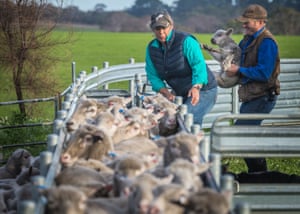
It almost seems idyllic until Andrew Bennett drives around the back of the property and rolling paddock collides with a sea of blackened scrub. Early on in the fires he had gone out west to help farmers defend their properties as the flames slowly built into an inferno. In some places Bennett says the earth burned so hot it cooked beneath the surface. As proof he points out a patch of blackened soil beside a gravel track where the grass will not grow.
It was only a combination of timing and preparation that stopped them losing everything. By the time the fire came to their property, it had already been burning for weeks and they had seen what happened out west. This meant they had time to bring their sheep in and follow their fire plan as the fire drew closer with the “third wave”.
A last-minute change of the wind meant the worst would never come. The day after, it rained.
“Nothing we did changed a thing,” Bennett says, recalling the firefighting effort. “At the end of the day the fire went where it pleased. Some blokes have gone through a lot. I’m worried they won’t recover from this, mentally or financially.
“I don’t know how long all this will take to heal. When we bought this property 14 years ago, it had just been through another fire. It had just started to look good again when this happened. All I want now to see is the black and ash gone.”
***
Many on Kangaroo Island would prefer not to talk about what happened with the fires. If they could, they would like to forget – even if it is impossible when visual reminders of what happened are everywhere. Driving west along Playford Highway, the scrub turns postcard picturesque to fairytale nightmare and back again in an instant.

These flashes only hint at the scale of the firestorm that scorched 211,474 hectares, or 49% of the island, according to some estimates. The fires burned consistently for three weeks from 17 December, killing more than 50,000 livestock, leaving many among the 4,000-strong community homeless and taking two lives, Dick Lang and his son, Clayton.
Even now some still do not have a permanent home and are instead living in caravans or the utilitarian “recovery pods” donated by groups such as the Minderoo Foundation. This means they are counted among the 25,000 Australians the International Displacement Monitoring Centre considers internally displaced after the disaster.
When people do talk about what happened, they describe events as taking place across three waves. First came the lightning strikes that peppered the western side of the island, setting off a series of spot fires. The second wave came around two weeks later when, having cornered the blaze in an area to the north-west, more lightning strikes ignited what came to be known as the Ravine fire.
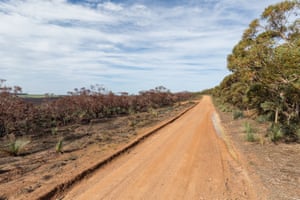
That blaze spread out towards Karatta on 3 January. Unknown to the locals, the state government at that time was preparing to evacuate people just in case. The Adelaide Convention Centre had been prepped and the Vasco da Gama – a cruise ship with 1,000-person capacity – had been parked offshore. Days later, on 9 January, the third wave began when the flames broke out and tore east towards Kingscote, forcing another mass evacuation.
For those who retreated to Kingscote that was a sleepless night. By then everyone had seen the images from the beaches of Mallacoota. As people sat with the army and watched the glow on the horizon, the smoke from burning gumtrees could be smelled as far as Adelaide.
Half a year on, the Parndana Country Fire Service station is quiet. The maps from January hang on the wall in the annexe where Terry May and Rodney Lade helped coordinate the firefighting effort across a 631km perimeter.
“Time shrinks,” May says. “At least it certainly does in our business. Time and space are really hard to keep a handle on [during a crisis]. You come in, start working out where to put your heavy machinery and resources, and it just goes. You can sit in here for 20 minutes and suddenly it becomes two hours.”
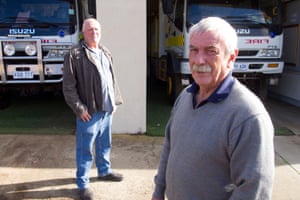
Between them May and Lade assisted the CFS Incident Management Team to coordinate 40 trucks and 300 volunteer firefighters across the island – some of whom lost their homes during those three weeks. Both say they knew going into 2019 that the fire season would be bad. The island’s weather patterns bring on storms and the laterite content of the soil makes it a magnet during a thunderstorm. It didn’t help there had been no rain since mid-October 2019 and the earth was a tinderbox.
The question was just how big it would get.
In the three weeks the fires raged, there were two moments where everything changed. The first came in the lead-up to 3 January when the Ravine fire broke out of containment. A few days later a bad situation turned worse when a pyrocumulus formed above a wooded area around Karatta.
“[Pyrocumulus clouds] happen when a fire gets real hot,” May says. “They build until they cool and then they collapse. When they do, it’s like a bomb going off.”
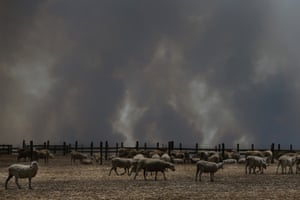
A fire that would normally move through scrubland at 4-5kmh and take six hours can instead spread in minutes backed by 140kmh winds. When the cloud dropped over Karatta, it spread fire out beyond Harriett Road. Three days later flames were charging down the Cygnet River towards Kingscote.
Today the pandemic has kept May and Lade from debriefing with their people about what happened, let alone speaking to the wider community. Instead they’ve quietly been taking stock. Since the fires they’ve had a trickle of new volunteers but both expect some regulars won’t stick around.
“There’s heaps of shell shock,” Lade says. “Some of our volunteers won’t continue. It’s been too big, too much.”
From a firefighting perspective, they say the important thing now is to make sure their lessons get passed on to the next generation in leadership. May says he had never seen a fire as big or ferocious in his 40 years with the CFS. If it happens again, they want to make sure those who take over from them are ready.
***
Around the corner from the CFS station is the Parndana Recovery Centre. Part information centre, part gathering place and part social service, the centre was activated to provide disaster relief. Today it has pivoted to supporting the recovery effort.
The centre is run by the SA Housing Authority’s regional manager, Melinda Rendell, and the Kangaroo Island resident Anna Osman, who was appointed asset program manager in March. Half a year on, they say the recovery is entering a new phase.
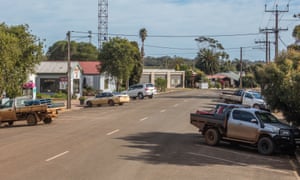
To date, $14m in government money has been distributed to help those on Kangaroo Island rebuild farms and business or cover loss of income. Another $2.29m in donations to the SA Bushfire Appeal has been distributed to 645 people. Meanwhile, what was left of the 119 homes and 106 other structures that burned have only just been pulled down and hauled away in recent weeks. The process was delayed when 106 sites were identified as containing asbestos – a problem on an island where everything has to come in by boat.
Now that is done the island has a clean slate, giving the community the chance to make plans for the future while coming to terms with grief, loss and survivor’s guilt.
“It’s natural and really common,” Melinda says. “You find the same after every disaster. It’s called complex grief. If we think about grief in the context of death, that’s a single loss. Complex grief is where it’s not so cut and dry.
“After a bushfire, some people may have lost their possessions but are grateful to be alive. Then there’s people who have lost a little, but not everything. And there are those who feel guilty because they survived unscathed.”
Anna says the experience has unified people. Whatever they’ve been through, everyone knows there isn’t a person on Kangaroo Island who has gone unaffected, whether physically or psychologically. All, at some point, were made to feel helpless.
“It was that feeling of being unsafe,” Anna says. “And being unsafe in your own home and space. It was being confronted by that question of: what if it comes over the hill?”
The result so far has been a deep community spirit. Neighbours check on neighbours. Problems – once identified – are often quickly and quietly seen to without the Recovery Centre even knowing. Everyone who can helps out where they’re needed.

When the crisis began, BlazeAid was among the many non-governmental organisations to mobilise. The volunteer organisation was formed after the 2009 Black Saturday bushfires to help farmers clear and rebuild boundary fences – a critical first step in recovery.
Out in a field somewhere behind Parndana is Steve Hewitt, who is working on a two-man crew sinking fence posts for a new boundary line. The retired high school maths teacher from Gawler, South Australia, has been volunteering with the organisation since the Pinery bushfire in 2015. He was among the original four volunteers who came over to set up camp at Kingscote Oval while the fires still burned and joined them when they moved camp to Parndana Oval.
“Those first few weeks after, the place felt like the warzone,” Hewitt says. “The ground was still smouldering in places and you could hear gunshots going off in the distance as farmers put down their stock.”
The scale of their task is massive. About 175 farmers have registered with the organisation for help, and while most have been contacted, there are still around 30 left. The group has so far cleared 1077km of fencing and erected another 511km, with hundreds more to go.
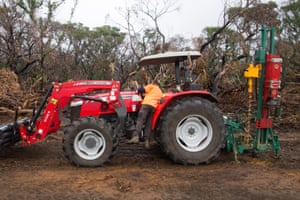
“We’re still coming across farmers who are really stressed out,” Hewitt says. “When we do, we sit and talk with them to work out a plan. Once they have an idea about what they want to do, they usually feel much more in control.”
Back at the group’s campsite, steady rain has turned the oval carpark to mud. At present there are 40 backpackers and international travellers living on site in caravans organised by the Lions Club. Initially, they had been sleeping in tents.
Before the pandemic, their number stood at 127, making this the largest camp in the country. Inside the hall, those who aren’t out working gather in front of an industrial-size heater for warmth. Among them is Flo, the second-longest serving volunteer. Three years ago she left the UK and eventually found herself on the east coast of Australia during the height of the crisis.
“Just prior to coming here we were travelling through New South Wales to try and get away from Batemans Bay through pure orange smoke,” she says. “We went through a number of camps for displaced persons before we ended up here. This was the only camp that would take us.
“I’d never heard about Kangaroo Island until then. It’s not advertised on any of the backpackers’ lists.”
Since then Covid-19 has made things difficult. When the pandemic started, Blazeaid was declared an essential service, but as international borders snapped shut individual volunteers were forced to make a choice: stay or go?
“People were in limbo,” Flo says. “What do we do with ourselves? It was no time to be travelling, but then for many it was also safer to stay on Kangaroo Island than it was to go home to places like London or Rio de Janeiro.
“Whatever we chose, we were told that if we were thinking about leaving, we had to decide quick.”
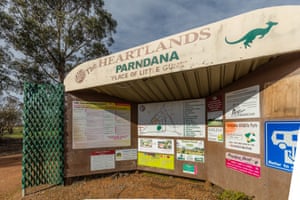
According to the South Australian Tourism Commission, tourism in the state was worth roughly $8bn in 2019. For Kangaroo Island, tourism represents a $147m business. With only 3,150 houses on the island, just 1815 of them are occupied all year round. The rest sit empty as second homes or rental accommodation, waiting for the tourists and travellers to arrive with the holidays.
The hope was this year might be the biggest on record. The fires, unexpectedly, put Kangaroo Island on the map and created an enormous amount of goodwill from people who wanted to help. Even as the embers smouldered, tour operators reworked their offerings to focus on bushfire ecology or advertise destinations that were off the usual tourist trail. With the pandemic, their bookings evaporated.
“We had to go into lockdown,” says Jon Lark. “The medical service here has one ventilator and one ICU. If Covid hit us, we were fucked.”
Lark and his wife, Sarah, are the owners of award-winning boutique gin distillery KI Spirits, which operates a cellar door 10 minutes outside Kingscote. The 58-year-old says the past six months hit the island like a one-two punch.
“I don’t have any shame in saying that I felt extremely guilty and extremely anxious because of what we’ve all been through,” Lark says. “We feel guilty because we didn’t lose anything. And I say that because I wasn’t out there fighting fires like some of my staff. Some of them lost homes and businesses.”
“And it’s the same right now for tour operators. We’re doing OK, but others? Last Saturday we did a tasting for World Gin Day in Tokyo by video. You can’t run a tour or serve a meal over the internet.”
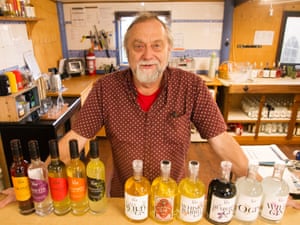
It won’t be easy, Lark says, but the island will make it through. Those in the tourism business are watching as interstate travel begins to open back up and authorities talk about setting up intra-regional flights to places like New Zealand.
Lark, like others, knows the future is not without risk. Winter is coming, which means the waters are already growing too choppy for the ferry to run. Each year there are roughly 50 days where there is no ferry at all, and air service has been patchy. Even before the pandemic, Rex Airlines cut the route to Kangaroo Island in February and only recently announced it would return services on 6 July.
Then there is the possibility another catastrophic bushfire or a second wave of Covid-19 may flare in the rush to reopen borders and reboot the national economy. All it would take, Lark says, is a group of careless tourists and they’d be right back where they were.
“You know, a while ago I made up some whisky and it’s about ready,” he says. “I said to my staff that if another fire happens again, we’re going to load up the whisky and we’ll all get the hell out of here.
“All jokes aside, though, the truth is no one knows what tomorrow looks like. But then what can you do? You can only deal with today and then next week. The rest is up to chance.”